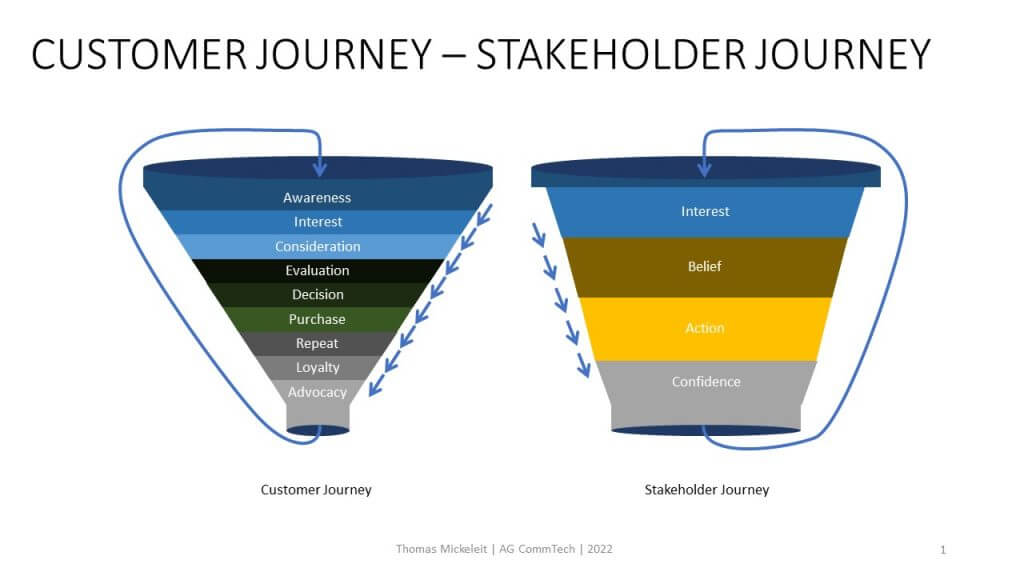- 2. February 2022
- Posted by: Die Redaktion
- Category: NEWS

Debate: Thinking about the Stakeholder Journey in European terms!

Author: Thomas Mickeleit
CommTech is sweeping across the Atlantic as a concept and new model for communication. With all sympathy and a bit of admiration, the idea of optimally developing all stakeholders into “fans and advocates” goes beyond the mark. The commercialization of relationships can have a dangerous effect on reputation in the end. Here is my plea for a European interpretation of CommTech in strict alignment with stakeholder interests.
When the Arthur Page Society presented the termCommTech in its 2019 study “The CCO as the pacesetter,” communications executives in this country were busy building newsrooms, implementing social collaboration tools, and sometimes (too) timidly practicing employee advocacy programs. None of this is wrong and yet not enough.
CommTech AG creates platform for exchange of transformation experiences
That communications, like other corporate functions before it-and like the country as a whole-must accelerate its digital transformation has become accepted. According to the surveys of the latest European Communications Monitor (2021), 89 percent of communications managers consider this to be important or very important. Not least because there is a lack of implementation, the CommTech working group was formed in the summer of 2021 to give PR practitioners a platform to share their transformation experiences and learn from each other.
However, the fact that the Arthur Page Society talks about CommTech as a new profession has less to do with the digitization of the value chain in communications and much more to do with a different understanding that underlies CommTech. In derivation of the Customer Journey, which at the end of the day should turn loyal customers into fans or advocates, this applies equally to stakeholders in communications, who should be “convinced” of the organization’s performance. As in the funnel of the customer journey, individuals (not target groups) are optimally influenced from stage to stage in the ongoing dialog and mutated into followers.

First of all, there is nothing at all wrong with the mechanics as such, even though a slight shiver may run down the spine of ethically sensitive communication people. Those who are on the verge of gasping at the words “Beeinflussen” will probably only find a retarded access to the idea of CommTech. Initially, it is just a matter of communicating with stakeholders at each stage of the customer journey in such a way that the communication is as valuable as possible for them and is therefore effective. As those responsible for communications, we must ask ourselves why we have so far left it at that, limiting our sphere of influence to the “Interest” level. As a result, all communication is “one size fits all” and geared to the assumed interests of the target group, i.e. it is not “customized”. Of course, we know better. The more communication is aligned with the specific sensitivities and interests of the target groups, the better it works.
Do not design the stakeholder journey from a corporate perspective
If the Arthur Page Society’s findings are anything to go by, “digital engagement systems” are being built for this purpose, on which the stakeholder journey is mapped and a continuous dialog takes place. But what does that mean and what should such platforms be like?
The urgent recommendation must be: Ask, what is the ultimate interest of the respective stakeholder group in the dialogue with the organization? Hardly surprisingly, this interest presents itself very differently. A university graduate who is a talent from a corporate perspective ends this Journey as a “New Employee”, an NGO representative as an enlightened voice in the field of her expertise, a journalist is sensibly not even subjected to the attempt to appropriate him. The stakeholder journey must therefore not be designed from the corporate perspective and is therefore fundamentally different from the commercially determined customer journey and also from the commercially determined approach to the stakeholder journey as it comes to us from the USA.
European reading of the Stakeholder Journey
The European reading of the Stakeholder Journey adapts the channels, formats, and tonality to the benefits it unfolds for the respective stakeholders, and it may also deliberately not end at the “Confidence” level in every case. We must not forget that the ultimate goal of communication is the increase of reputation, the guarantee of the license to operate. This must also be the benchmark for us when designing the Stakeholder Journey. No more, no less.
About the author: Thomas Mickeleit, formerly Director of Communications Microsoft Germany, is now a communications consultant for Digital Transformation. He wrote the above article in his capacity as head of the CommTech working group, which was founded under the umbrella of the Institute for Management and Economic Research (IMWF), Hamburg, in the summer of 2021. The CommTech WG develops solutions for digital communication and presents them to the interested professional public.
1) The CCO as the Pacesetter, ArthurPage Society, 2019https://knowledge.page.org/wp-content/uploads/2019/09/CCO_as_Pacesetter_2019_Page_Research_Report_Interactive.pdf
2) Zerfass, A., Buhmann, A., Tench, R., Verčič,D., & Moreno, A. (2021). EuropeanCommunication Monitor 2021. CommTech and digital infrastructure,video-conferencing,and future roles for communication professionals. Resultsof a survey in 46 countries. Slide 16 ff.
3) WG1 of the CommTech working group follows this approach and formulates this idea of the “European reading of the stakeholder journey” developed from the stakeholder perspective.

